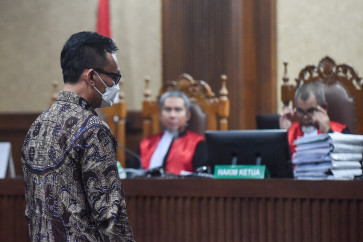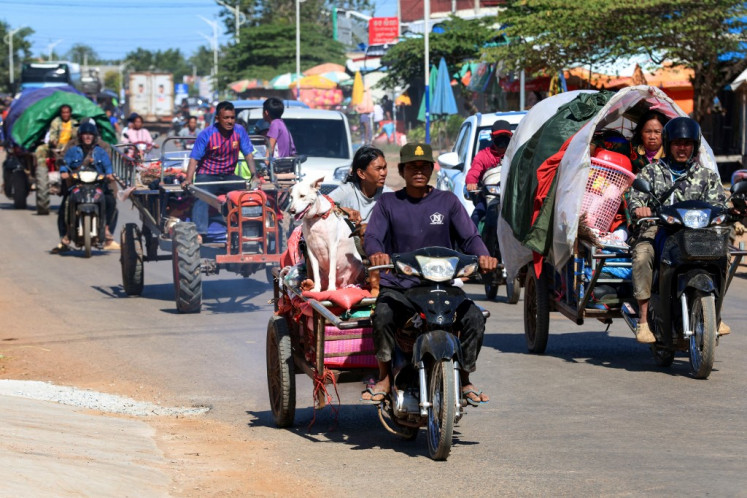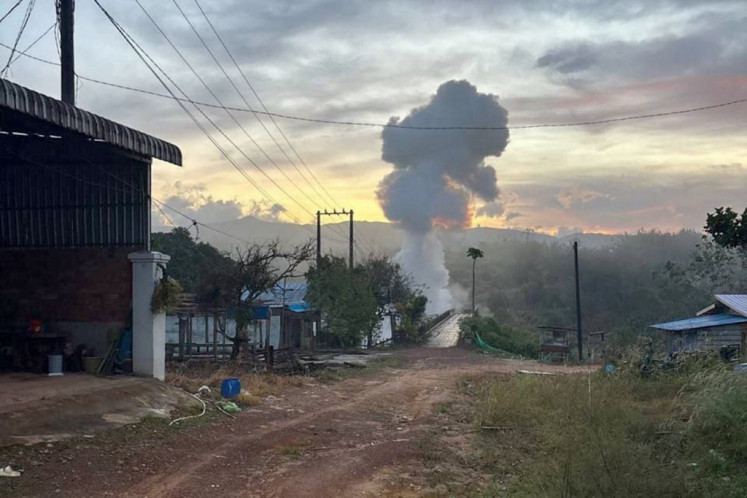Popular Reads
Top Results
Can't find what you're looking for?
View all search resultsPopular Reads
Top Results
Can't find what you're looking for?
View all search resultsDevelopment of rail-based public transportation on track
As the use of private vehicles to commute in Greater Jakarta remains the top option, more rail-based transportation might be the answer to worsening traffic
Change text size
Gift Premium Articles
to Anyone
As the use of private vehicles to commute in Greater Jakarta remains the top option, more rail-based transportation might be the answer to worsening traffic. However, the development must be pushed, an official has said.
Besides limiting the use of private vehicles through the odd-even license plate policy and electronic road pricing, railway transit was considered the future of urban transportation, Greater Jakarta Transportation Agency (BPTJ) head Bambang Prihartono said.
“Bus service is not a sustainable option; railway-based transportation is the answer,” he said in a recent discussion.
Bambang explained that the best way to get people to shift to public transportation was by designing public transportation service that moved around people and the location of their activities, which in other words was accessible to everyone.
He cited BPTJ data that said more than 88 million trips were made by 31 million people in Greater Jakarta every day, creating traffic congestion.
Bambang urged the government to take bold steps to realize the development of rail transit in Greater Jakarta as the backbone of mass transportation. He said the plan had been laid out in the 2019-2029 Greater Jakarta Transportation System Blueprint (RITJ). The blueprint is supported by a 2018 presidential decree stating that 60 percent of the area’s trips should be covered by mass transportation services by 2029.
Three operators manage rail-based services in Greater Jakarta, particularly in the capital city, namely city-owned MRT Jakarta, city-owned LRT Jakarta and a commuter line service operated by PT Kereta Commuter Indonesia (KCI), a subsidiary of state-owned PT Kereta Api Indonesia (KAI).
Within two years, the city can expect to welcome newcomer Greater Jakarta LRT, developed by PT KAI.
Inaugurated in March, MRT Jakarta serves about 88,000 people per day as of October on its only corridor linking Lebak Bulus in South Jakarta to the Hotel Indonesia (HI) traffic circle in Central Jakarta.
MRT Jakarta operational and maintenance director M. Effendi said he was optimistic that the target to serve 100,000 passengers on daily basis by the end of 2019 could be achieved.
“In fact, MRT Jakarta can actually serve a maximum 173,000 passengers per day,” he told journalists on Friday.
As the company continues to improve its service on its south-north corridor, Effendi said MRT Jakarta was nearly ready to develop the second phase spanning from the HI traffic circle to Kota in West Jakarta and to Ancol in North Jakarta, where it will build another train depot.
Amid the passenger growth, Effendi is optimistic that MRT Jakarta could dominate rail-based services in the future, especially once all of its lines were operating.
He explained that in the future, MRT Jakarta would have 240 kilometers of railway track. Aside from the south-north line, there will be an east-west line, a circle line within Jakarta and another surrounding the city.
“I predict that MRT Jakarta will be able to serve 70-80 percent of the city’s total train trips. As long as we can build stations to support travel of at least 1 km, people will be willing to use our service,” he said.
The company aims to complete the construction of phase two by 2025.
MRT Jakarta has been integrated with the city’s one and only bus rapid transit, Transjakarta, at some of its stations, such as Dukuh Atas and Bundaran HI to boost the mobility of its passengers.
The company has also forged cooperation with state electricity firm PLN as the sole power supplier to support MRT Jakarta operations. Although it was affected by a massive blackout in Jakarta in August, Effendi said the company planned to build its own power plant.
“For now, we’ve been bounded by a partnership with PLN. But having our own power plant will make sense when our 240 km line is fully operational,” he said.
Another city-owned railway-based transit service, LRT Jakarta, is developed by city-owned builder PT Jakarta Propertindo (Jakpro) and operated by its subsidiary, PT LRT Jakarta.
Its first line spans 5.8 km from Kelapa Gading in North Jakarta to the Jakarta International Velodrome in Rawamangun, East Jakarta.
The more popular and more spread-out railway-based public transportation system is the commuter line. As the oldest player using railways under KAI, KCI can reach deep into satellite cities.
Its furthest stations are in Rangkas Bitung in Lebak regency, Banten, and Nambo in Bogor, West Java.
The commuter line serves around 1 million passengers daily. It aims to serve 1.2 million passengers per day and a total of 343.5 million passengers by the end of 2019.
In a press statement, KCI spokesperson Anne Purba said the company owned 1,020 cars as of July this year.
“The new car procurement is part of our attempt to upgrade our fleet and increase our capacity. With the additional trains, we will be able to operate more 10-car and 12-car train sets,” Anne said.










